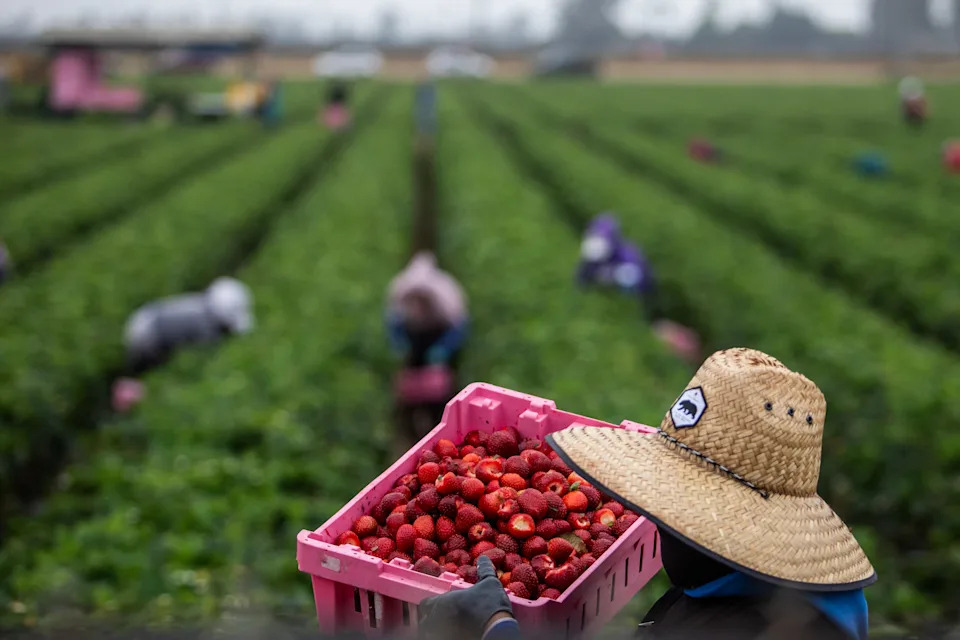There were more empty seats than usual on the charter bus when the Lyndon B. Johnson High School football team departed campus earlier this summer.
Several families chose not to send their sons to the Texas state 7-on-7 tournament even though it was the first time LBJ had ever qualified.
Parents of those players told LBJ coach Leo Mireles they were concerned about an immigration checkpoint on the highway out of town. They did not want to risk their sons being detained at a time when President Donald Trump is pushing for mass deportations and social media is littered with videos of masked federal agents arresting migrants in the country illegally.
LBJ draws students from the lowest-income parts of Laredo, a sprawling South Texas city of more than 250,000 on the border between the U.S. and Mexico. More than 99% of the student body is Hispanic, according to U.S. News & World Report.
“Parents in our community are scared,” Mireles told Yahoo Sports. “We’ve had fewer kids ever since these raids started, not only our athletes but also just fewer students attending school. I've always used athletics as a place for kids to come and feel part of something, so right now, when they're not here, I just know they're going through a lot of tough times.”
The issues that Mireles described are not unique to LBJ. High school football programs from other immigrant-heavy areas across the country have also experienced sharp declines in turnout for summer practices and workouts, especially after reports of Immigration and Customs Enforcement agents patrolling their communities.
Yahoo Sports reached out to more than a dozen high school coaches and athletic directors in areas of California, Florida, Texas and Arizona with large immigrant populations. The responses ranged from programs entirely unaffected by the threat of ICE raids to those trying to support athletes whose mom or dad had been deported or whose parents had retreated into hiding.
Often, the situations varied wildly at different high schools in the same city. That was especially true in Salinas, a Northern California city known as the “Salad Bowl of the World” because of the diverse set of crops that grow in its rich, fertile soil and temperate climate.
Football roster numbers are “status quo” at North Salinas High this season despite the threat of illegal immigration raids, coach Ben Ceralde told Yahoo Sports. It’s the same four miles to the south at Salinas High, according to football coach Steven Zenk.
“The only fear I see is centered around how much we are running today,” Zenk joked.
Then there’s Alisal, the easternmost high school in Salinas, the school erected less than a football field away from the nearest fields of leafy lettuce and strawberries. The Alisal neighborhood originated as a refuge for migrant farm workers who were considered undesirable by Salinas’ white city leaders. Even now, nearly a century later, the largely Hispanic student body at Alisal High is loaded with sons and daughters of agricultural workers.
Alisal football coach Francisco Estrada told Yahoo Sports that his team drew an average of roughly 130 players for voluntary workouts this summer. That number plummeted by about 25-30, according to Estrada, anytime there were reports of ICE raids in the Salinas area.
“Our high school is definitely impacted more than any other high school in our district because of our demographics and how many of our students have parents or older siblings who work in agriculture,” Estrada said.
“Obviously parents are worried about being out in the streets and dropping kids off, but I also think our student-athletes have a genuine fear when these incidents come about. At times, it’s not because of whatever legal status they’re in. It’s the status that their parents are in, their brothers, their guardians, their uncles. They want to be there to support their family.”

Threat of deportation is real
To many Trump supporters, the anxiety and unease of undocumented immigrants is proof his policies are working. Trump campaigned on the promise to wage war on illegal immigration even more aggressively than he did in his first term. He vowed to beef up border security, to enforce immigration laws and expedite deportations as Customs and Border Protection recorded more than 10.8 million encounters since 2021.
Illegal border crossings in June dropped to the lowest level ever recorded, according to U.S. Customs and Border Protection. On August 1, U.S. Secretary of Homeland Security Kristi Noem proclaimed this “the most secure the border has ever been” after another record low month in July.
“We’ve put the cartels on defense and taken our border back,” Noem added.
In late May, White House Deputy Chief of Staff Stephen Miller told Fox News that he’d set a goal for 3,000 ICE arrests per day. By the start of this month, the Trump administration claimed to have arrested "nearly 150,000 illegal immigrants" since Trump took office in January.
While Homeland Security boasted Monday that ICE is removing drug traffickers and pedophiles from American communities, critics contend that the Trump administration is exaggerating how often it targets the so-called “worst of the worst.” The CATO Institute, a libertarian think tank in favor of open borders, has obtained nonpublic data tracking ICE arrests since last October. Ninety-three percent of those ICE detainees had never been convicted of any violent offenses. Sixty-five percent had no criminal convictions at all.
Immigration raids have been especially relentless this summer in Los Angeles. Masked ICE agents, California governor Gavin Newsom has argued, are “snatching hardworking people off the streets — ripping them away from their families and disappearing them into federal detention labyrinths just to meet indiscriminate arrest quotas.”
On the July day that heavily armed immigration agents descended upon MacArthur Park in a largely immigrant Los Angeles neighborhood, Contreras Learning Center football coach Manuel Guevara was holding a summer workout less than a mile away. Twenty kids did not show up because their parents didn’t want them leaving the house that day.
Many Contreras players gradually returned to practice. One so far has not. For weeks, that player told Guevara that his mom didn’t want him leaving the house, except to drive her to and from work. Only now, he says his mom is beginning to relax.
The threat of deportation is very real to Contreras families because it just happened to one of their own. Nory Sontay Ramos, a 17-year-old honor-roll student and track athlete at Contreras, showed up with her mom to what she thought was a routine meeting with immigration officials on June 30. Only days later, Sontay Ramos and her mom were on a plane to Guatemala, a country where neither of them had lived in more than a decade.
“I had literally just seen her two or three days beforehand,” Guevara told Yahoo Sports. “So when that happened, I was like, ‘Is this a joke?’ I didn’t want to believe that could have happened to her.”

'A lot of people who are scared'
Sixty miles north of Los Angeles, along California’s Central Coast, sits a predominately Hispanic seaside city of 200,000 built on sugar beets. Oxnard began to blossom in the 1890s when Henry T. Oxnard invested $2 million to build a factory to extract sugar from sugar beets and laborers from Mexico, China and Japan flocked to the area to work there.
As strawberries took over as Oxnard’s top crop and the city became known as California’s strawberry capital, the demand for a larger workforce created a flourishing Latino community. Recent ICE raids in the area have focused on the strawberry fields and other agricultural fields, raising concerns about the economic disruption and stoking fear and uncertainty among Oxnard’s farm workers.
Alex Morfin is the football coach at Hueneme High School in South Oxnard, the blue-collar part of the city where most of the farmworkers live. Nearly 94% of the school’s student population is Hispanic, per US News & World Report. In previous years, Morfin could count on drawing 90 players for summer practices and 50-60 for early-morning weightlifting sessions. This year, he was lucky if half that many players attended.
“The messages that I would get from our kids were things like, ‘My parents are scared for me to leave the house, so I can’t make it,’” Morfin told Yahoo Sports.
Morfin regularly reaches out to absent players, encouraging them to take all the time that they need but offering to drive them to and from practices if it would help. Some take him up on that offer. Others aren’t comfortable yet.
“It’s just sad,” Morfin said. “They’re attacking the wrong people. Our people here in South Oxnard, they’re not here to cause trouble. They’re here to work and make a living just like everybody else.”
The football coach at Bowie High School in El Paso, Texas, would have been thrilled to get 50 players to attend workouts this summer. Andres Vale told Yahoo Sports that he averaged maybe 15 kids, not even enough to scrimmage.
“It’s horrible,” Vale said. “It’s very depressing.”
The border wall separating the U.S. and Mexico is just about 100 yards behind Bowie’s campus. One of the bridges linking El Paso with Ciudad Juarez practically spills into the high school. Many Bowie students have lived in Juarez, but as holders of U.S. passports or long-term visas, were able to legally walk across the border every morning and get their education in El Paso.
Vale attributes Bowie’s low attendance in classes and football practices to that daily back and forth becoming riskier since Trump returned to office. Parents who are U.S. green card holders but reside across the border in Mexico fear they could be putting their immigration status in jeopardy by crossing back and forth or having their kids do so.
“There’s a lot of people who are scared, honestly,” Vale said. “There’s a lot of people who don’t want to travel as much.”
Among those are the teachers and coaches at Bowie. Some could be out of work if enrollment sharply declines this school year. Bowie could go from having varsity, JV and freshman football teams a few years ago to only fielding a varsity team this season.
“If we don’t get those kids from over there here to this school, a lot of us will lose jobs, plain and simple,” Vale said.
As Vale waits to see how many players he’ll have this fall, Mireles has shifted his focus to one player in particular. The Laredo LBJ coach has a rising sophomore who started skipping practices, classes and even games after his dad was deported last fall.
The player told Mireles that his mom works in San Antonio, about 150 miles north of Laredo. As a result, the teenager has become responsible for dropping his siblings at elementary school, picking them up and taking them to daycare. He also has a job to help support the family.
It’s Mireles’ goal to try to persuade him to make time for school and football, to try to “get some normalcy in his life where he has his friends and he can be a kid again.”
“Because him going home, it's I gotta go to work, I gotta take care of my siblings, I gotta figure out the bills,” Mireles said. “A 15-year-old kid should not be worrying about that. So I can only imagine the stress he's going through.”
Last spring, Mireles emphasized to this player the need for him to finish school and set himself up for something other than a minimum-wage job. He also hoped the teenager would be able to carve out time to participate in offseason football workouts.
Said Mireles grimly, “I haven’t seen him all summer.”







Comments